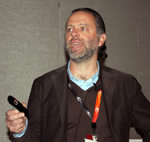The higher your herd's production average is, the more additional money you stand to make by making even small improvements in reproduction - more cows caught in heat sooner, more and earlier pregnancies, and shorter calving intervals.
 This message came from Greg Bethard (pictured), a dairy consultant and the assistant director for dairy technology at Dairy Records Management Systems at North Carolina State University, during the 7th annual Dairy Cattle Reproduction Council annual meeting in Sacramento, Calif., November 8 and 9.
This message came from Greg Bethard (pictured), a dairy consultant and the assistant director for dairy technology at Dairy Records Management Systems at North Carolina State University, during the 7th annual Dairy Cattle Reproduction Council annual meeting in Sacramento, Calif., November 8 and 9.
His high-velocity talk emphasized that no matter where a herd is currently in terms of milk production or reproduction - poor, average, very good or great - even moving up one rung on the performance ladder generates substantial additional income. Factors he cited in this include fewer cows over 300 days in milk, shorter calving intervals, more cows available for culling and lower overall replacement cost per head.
"The income-over-feed-cost (IOFC) benefit of improving herd reproduction has more financial impact on older cows than on heifers and on higher-producing herds than on lower herds," said Bethard. "But great reproduction results in lower feed costs per hundredweight in all herds. And in my experience, better reproduction has a bigger impact on the milk:feed ratio than the [data analysis] results imply, suggesting that something more than biology and demographics is involved."
Based upon his analysis of over 200,000 cow records in his consulting database, he estimates that making the leap from being a poor reproduction herd to a great one would improve IOFC by $515 per cow per year in a high-producing herd and by $387 per cow per year in a low-producing herd.
 This message came from Greg Bethard (pictured), a dairy consultant and the assistant director for dairy technology at Dairy Records Management Systems at North Carolina State University, during the 7th annual Dairy Cattle Reproduction Council annual meeting in Sacramento, Calif., November 8 and 9.
This message came from Greg Bethard (pictured), a dairy consultant and the assistant director for dairy technology at Dairy Records Management Systems at North Carolina State University, during the 7th annual Dairy Cattle Reproduction Council annual meeting in Sacramento, Calif., November 8 and 9.His high-velocity talk emphasized that no matter where a herd is currently in terms of milk production or reproduction - poor, average, very good or great - even moving up one rung on the performance ladder generates substantial additional income. Factors he cited in this include fewer cows over 300 days in milk, shorter calving intervals, more cows available for culling and lower overall replacement cost per head.
"The income-over-feed-cost (IOFC) benefit of improving herd reproduction has more financial impact on older cows than on heifers and on higher-producing herds than on lower herds," said Bethard. "But great reproduction results in lower feed costs per hundredweight in all herds. And in my experience, better reproduction has a bigger impact on the milk:feed ratio than the [data analysis] results imply, suggesting that something more than biology and demographics is involved."
Based upon his analysis of over 200,000 cow records in his consulting database, he estimates that making the leap from being a poor reproduction herd to a great one would improve IOFC by $515 per cow per year in a high-producing herd and by $387 per cow per year in a low-producing herd.







